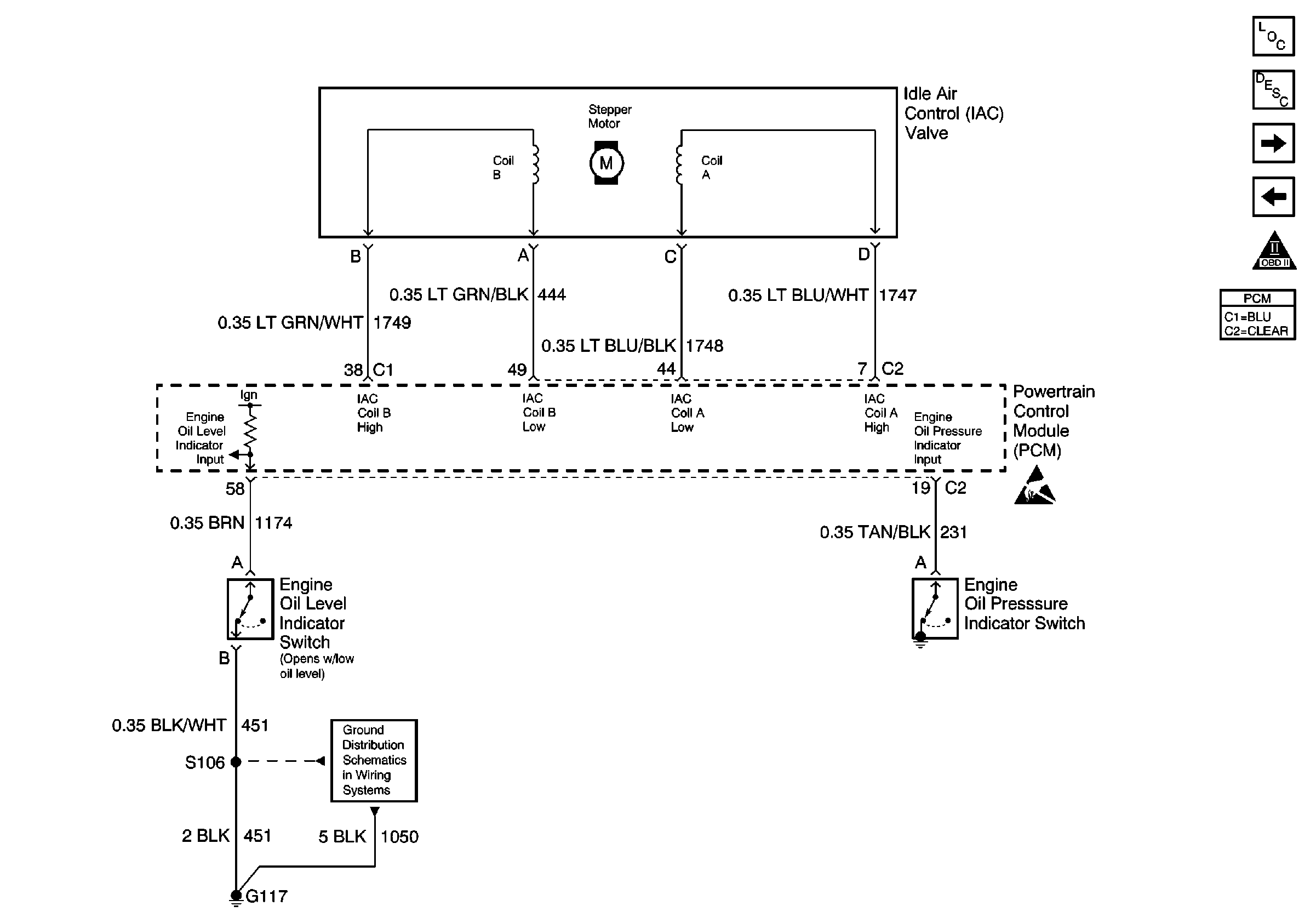Refer to
Idle Air Control Valve Inputs

.
Circuit Description
The PCM applies battery voltage through a pull up resistor to the engine oil pressure (EOP) switch circuit. The PCM monitors the applied voltage on the EOP switch circuit. If the ignition switch is turned ON with the engine not running or engine oil pressure is below 35 kPa (5 psi), the EOP switch grounds the PCM voltage input. The PCM sends the EOP information through the Class II serial data to the Instrument Panel (IP) Cluster. The IP Cluster controls the EOP indicator.
Diagnostic Aids
Inspect for the following conditions:
Many situations may lead to an intermittent condition. Perform each inspection or test as directed.
Important: : Remove any debris from the connector surfaces before servicing a component. Inspect the connector gaskets when diagnosing or replacing a component. Ensure that the gaskets are installed correctly. The gaskets prevent contaminate intrusion.
| • | Loose terminal connection |
| - | Use a corresponding mating terminal to test for proper tension. Refer to Testing for Intermittent Conditions and Poor Connections , and to Connector Repairs in Wiring Systems for diagnosis and repair. |
| - | Inspect the harness connectors for backed out terminals, improper mating, broken locks, improperly formed or damaged terminals, and faulty terminal to wire connection. Refer to Testing for Intermittent Conditions and Poor Connections , and to Connector Repairs in Wiring Systems for diagnosis and repair. |
| • | Damaged harness--Inspect the wiring harness for damage. If the harness inspection does not reveal a problem, observe the display on the scan tool while moving connectors and wiring harnesses related to the sensor. A change in the scan tool display may indicate the location of the fault. Refer to Wiring Repairs in Wiring Systems for diagnosis and repair. |
| • | Inspect the powertrain control module (PCM) and the engine grounds for clean and secure connections. Refer to Wiring Repairs in Wiring Systems for diagnosis and repair. |
If the condition is determined to be intermittent, reviewing the Snapshot or Freeze Frame/Failure Records may be useful in determining when the DTC or condition was identified.
Engine Oil Pressure Switch Diagnosis
Step | Action | Values | Yes | No |
|---|---|---|---|---|
1 | Did you perform the Powertrain On Board Diagnostic (OBD) System Check? | -- | ||
2 | Are any IP Cluster, BCM, PCM, or UXXXX Communication DTCs stored? | -- | Go to applicable DTCs | |
3 | Is the engine oil pressure Indicator on? | -- | ||
4 | Inspect the engine oil level. Refer to Fluid and Lubricant Recommendations in Maintenance and Lubrication. Is the correct engine oil level indicated? | -- | Go to Oil Consumption Diagnosis in Engine Mechanical | |
5 | Test the engine oil pressure with a manual pressure gauge. Refer to Oil Pressure Diagnosis and Testing in Engine Mechanical. Is proper engine oil pressure indicated? | -- | Go to Oil Pressure Diagnosis and Testing in Engine Mechanical | |
6 |
Did the test lamp illuminate? | -- | ||
7 | Test for the following circuit conditions:
Did you find and correct the condition? | -- | ||
8 |
| -- | ||
9 | Test the IP Driver Information Display for correct operation. Refer to ENGINE OIL PRESSURE Message Always On , or ENGINE OIL PRESSURE Message Inoperative in Instrument Panel, Gauges, and Console. Did you find and correct the condition? | -- | ||
10 | Replace engine oil pressure switch. Did you complete the replacement? | -- | -- | |
11 |
Important: : The replacement PCM must be programmed. Replace the PCM. Refer to Powertrain Control Module Replacement/Programming . Did you complete the replacement? | -- | -- | |
12 | Test for the proper operation of oil pressure Indicator. Refer to Diagnostic Starting Point - Instrument Panel, Gages and Console in Instrument Panel, Guages and Console and Oil Pressure Diagnosis and Testing in Engine Mechanical. Is the correct operation indicated? | -- | -- |
